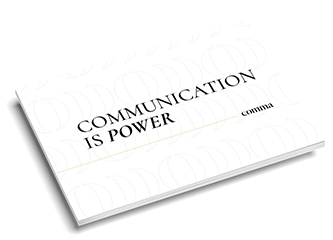Being a good spokesperson is not a matter of luck. Or not only that. There are people who, with hardly any training as spokespersons or specific knowledge, are able to speak clearly and effectively, to understand almost instinctively the usefulness of a message, what a frame is and how it is created or moved, how the media work… There are professionals with more or less ability in this aspect, just as there are those who have a special predisposition for music or for swimming or for finding their way around an unfamiliar city. But even with this ability, it will require preparation, just as a musician requires rehearsal.
Most commonly, however, you will need spokesperson training if you are going to be a spokesperson for an organisation or public activity of any kind. To begin with, let’s assume that you know how important it is to insert spokesperson activity into a communication strategy that is well designed and laid out. No matter how good a spokesperson you are, if you are not clear about your messages, their impact and their purpose, your work and your flamboyance are likely to be, at best, useless, if not counterproductive.
Everything communicates
At comma we defend a well-proven theory: everything communicates. Yes, both your presence and your absence communicate. Not going where someone asks you to go to talk about a topic in which you are relevant is a way of conveying a message, usually a negative one. The space in your sector that you do not occupy will be occupied by someone else.
The way you dress, your gestures, the words you choose to express yourself also communicate. The examples you give, how often you smile, and how you do it, whether it is more or less forced… Everything! Good personnel trainers for call centers know that if you speak with a smile, that smile shows on the other end of the phone. But you can also tell if the smile is fake: smiling doesn’t sound the same as gritting your teeth. Eyes don’t cheat either, they lie, but they don’t cheat.
When we face a spokesperson training, one of the first suggestions we propose to the person we are going to train is to disarm, to take off the corsets, the armours, the protections, and to relax. We are going to have fun, we are going to play with your ego, we are going to break it into little pieces and we are going to put it back together so that you come out stronger, knowing yourself better and with new and fundamental skills when you have to effectively convey an interesting and useful message to and about your organisation. We are not going to give them another voice, we are going to find their own voice, and for that we try to make them as relaxed as possible. And we usually succeed.
Knowledge of the environment: back to school

The first challenge is to make them aware of the communicative universe in which they operate, i.e. what they call “knowledge of the medium” at school. Usually, he thinks he knows it only because he reads and understands articles and news items in the press. Nothing could be further from the truth: the product of the press is simple to understand because that is precisely its function, but behind that product, there is an elaboration process that has a myriad of peculiarities. For example: behind the best key message ever (in my opinion) there is a work of decantation, analysis of the discourse and the spokesperson, search and find, which has a lot of thinking, strategy, training and a little bit of luck. It was so good that Ciudadanos copied it from PSOE. The “burns” were not born with the networks, as we can see, and in fact, the “go away, Mr. González” was a hit refrain that is still remembered today.
Once the communicational paradigm in which we move is well understood, liquid, unfriendly and stark, the apprentice spokesperson should understand that in this map, trust in institutions has decreased, and faith in leaders has grown, although not in all of them.
The most recent Edelman confidence barometer shows how the level of trust in leaders varies from country to country, but in general, trust in government leaders is low. For example, in the UK, confidence is 29%, while in China it is 86%. For business leaders, confidence is high, with 95% in Indonesia, 91% in India and 88% in Saudi Arabia. In general, trust in political leaders is low compared to other groups, such as scientists or CEOs of companies.
Spain, among the most distrustful
In Spain, this trend is even more pronounced: trust in leaders in Spain has declined, with a trust index of 42% in 2024. This places Spain among the countries with the lowest confidence in leaders, and represents a significant change of -7 points from the previous year. Therefore, Spain is among the countries with the highest index of distrust in leaders, according to the data of this annual barometer.
Parallel to this loss of trust in leaders, mistrust in the media (as in all other institutions, NGOs, etc.) remains a problem, because that is precisely where leaders like to go, and for that they hire consultancies like comma, and spokesperson training like the one we usually offer to our clients.
What and who do people trust? Interestingly, one of the most paradoxical revelations of this Barometer is that people trust scientists (what a great opportunity) and their peers. In other words, people tend to give the same level of credibility to what an eminent biotechnologist publishes in the most important indexed journal in her field as they do to what your paddle tennis partner posts in the office WhatsApp group.
If we really don’t see any problem with it, go ahead. Let us continue on the path of speaking to be heard, to impress our competitors, to defend ourselves against journalists and their sometimes uncomfortable questions. But it might be possible to start talking to people as their equal, their partner, their friend, without becoming a ‘Fernando Galindo’, of course. An equal. How many CEOs of large companies, how many political leaders, are capable of doing that?
To be a good spokesperson you also have to understand something else: what I teach you today may be old or incomplete tomorrow. Those who struggled to speak on television in the 1990s had to learn to do so on networks in the 2000s and on tik tok (which is something else) in the Roaring Twenties of this century. As communication is a deeply technologically mediated profession, it is necessary to adapt to developments and learn how to deal with them. Are you ready to be interviewed by an artificial intelligence? Maybe you should.
Framing: How to get people to look where you are aiming and not somewhere else.
One very interesting thing is the frames and how to fix them: framing which, despite being older than time, still works as well as it did on the first day. Not to be confused with the message. The message is part of a strategy of framing in which it is essential to choose the right semantic field of words in order to ensure that the discussion on a topic that interests you takes place on a playing field that you have designed with a prior strategic objective in mind.
Spokespeople need to learn that, once the strategic objective is defined, there is a framework in which the conversation around that objective is favourable. For the public conversation around your target to develop in that field, the choice of words will be crucial. For example: if you are a tobacco entrepreneur and you want to influence public opinion in favour of smoking in open spaces such as terraces or parks, perhaps the key message should not be “smoking outdoors does not harm anyone”, but rather “scientific evidence shows that open spaces are ideal for enjoying freedom without disturbing anyone; there is enough space for everyone”.
Let’s play taboo

To avoid talking about smoking, harm, smoke, etc., we can use the famous game Taboo® with which you have to describe something without mentioning a word or words that are forbidden. I highly recommend playing taboo with future spokespersons, it trains and entertains them, which are things that many letters share. See? You’re already looking at letters and etymology, and you’ve forgotten what we were talking about here. I moved the frame in a moment and you might not have noticed.
Taboo® is not the only game to be played in good spokesperson training. Role-playing games, in which the future spokesperson is subjected to an impromptu press conference with a camera over his or her shoulder (canutazo), to a press conference with journalists, to the need to address a speech, to an intervention in a speakers’ gallery… are fundamental to analyse the result and to improve their oral expression, their dress, their tone of voice and their gestures, all in the hope that the spokesperson trains daily so as not to forget the theory, useful training of enormous complexity.
Often our trainees in spokesperson training are surprised by this fact that anthropologist Albert Mehrabian of UCLA offered us a long time ago: only 7% of communication is verbal. Tone and voice account for 38%, and the remaining 55% is your attitude and body language.
But then, you ask, where is the message? The message, dear reader, is you.







